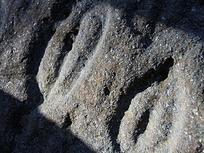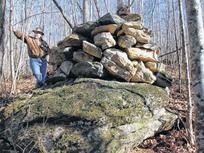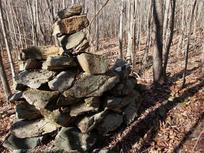For 40 years, Mark Williams has researched ancient Indian sites.

Vino Wong, vwong@ajc.com Stone carvings in boulders at Track Rock led an amateur historian to theorize the mounds in Brasstown Bald are tied to a long-lost Mayan civilization and became an Internet sensation.

Vino Wong , vwong@ajc.com Tommy Hudson stands near a rock formation in North Georgia that a noted author/historian believes was left by Mayans.

Vino Wong, vwong@ajc.com Mysterious rock piles seen along the unbeaten path near Arkaquah Trail are tied — some say — to a long-lost Mayan civilization. Others, however, think the notion is bunk.
He’s lectured at dozens of seminars. He’s written countless articles.
But the University of Georgia archaeology professor has never received attention like this. A preeminent expert on prehistoric times in Georgia, Williams was cited in an article last month that declared that a thousand-year-old Mayan ruin was discovered in North Georgia.
Architect/historian/author Richard Thornton theorizes that bands of Mayan peasants, fleeing a collapsing civilization, made their way to the North Georgia mountains near Blairsville. The article — on a site called examiner.com — surmised that a collection of hundreds of rock terraces and small mounds was the work of the Maya people, not locals.
These days, Mayans and their long-ago predictions of the world’s impending doom are a hot topic. So Thornton and his theory, which blends science and fable, have become an Internet sensation, spreading as fast as the latest Kardashian stunt.
Thornton declares that an area near Brasstown Bald is “possibly the site of the fabled city of Yupaha, which Spanish explorer Hernando de Soto failed to find in 1540, and (is) certainly one of the most important archaeological discoveries in recent times.”
Thornton uses Williams’ research on Indian mounds and the studies of archaeologist Johannes Loubser, who excavated the north Georgia site, to bolster his claims.
Williams couldn’t disagree more. “This is total and complete bunk,” Williams wrote on Facebook. “There is no evidence of Maya in Georgia. Move along now.”
Williams’ reaction brought forth legions of bloggers and Internet experts calling him “arrogant” and “dismissive.”
“That’s the way with the Internet,” said Williams, who was weary of the matter when reached last week for an interview. “There’s a feeling that people are hiding the truth. Someone needed to stand up and say, ‘This is silly.’ ”
The site referred to by Thornton has more than 300 rock structures — perhaps 500 — sprinkled on the side of the mountain, some of them dating back to 800 A.D., which correlates to when the Mayans, a highly developed society in Mexico and Central America, seemed to disappear. The demise of the long-running civilization has puzzled researchers for years. Drought, over population and war are leading theories. Thornton contends that the North Georgia formations resemble Mayans structures and that the timing of when they were built coincides with a possible Mayan diaspora.
Williams is not sure how the rock structures came about or who built them, “But it’s a wonderful mystery without having to bring in the Mayans or people from Mars.”
Loubser, who excavated a rock wall and waist-high mound at site (it is called 9UN367 — the 9 stands for Georgia, UN for Union County and 367 for the project number) and authored a report in 2010, chuckled at all the fuss.
“I think that [Thornton] selectively presents the evidence,” said Loubser. “But he’s a better marketer than I and other archaeologists are. When you make a claim like that, you have to back it up with hard evidence. There’s a lot of opinion out there. But archaeology is back-breaking work.”
Archaeology is not Indiana Jones. It’s often a lonely activity filled with shovels and dirt screens and carbon-dating and sunburn and published findings that are nearly anonymous.
Loubser, in his report, did not say who he thought erected the structures, although he figured the Cherokees or an earlier tribe were likely candidates. The two areas excavated, according to soil testing, were built somewhere between the years 800 and 1100. Loubser stopped excavation at the rock pile because there was evidence it was a grave.
Some piles could be burial sites of fallen warriors, he said. Also, he notes the area contains springs and a natural underground “vent” that releases warm air in the winter. The report said Indians referred to these “portals to the underworld” and the structures could be ceremonial.
Thornton, reached this week at his home near the site, dismisses his dismissals.
“I’m not an archaeologist. I’m a big picture man,” said Thorton, an architect who fell on hard times because of the economy and has thrown himself headlong into research of his Creek Indian heritage. He has written books, created computer-generated models of Indian settlements and has joined up with a research group to investigate their Native American past. “We have an open sharing agreement. We have an advantage over the regular archaeologists.”
In his article, Thornton said early maps of the area use the word “Itsate” for two villages, which is what Itza Mayans called themselves. This, coupled with the terraces and the date when some of the structures were built, led him to his conclusion.
“It’s identical to sites in Belize,” he said. “We’re hoping this article stirs up some interest. I was just trying to get the archaeologists to work some more on the site and they come back snapping like mad dogs.”
Carey Waldrip, who lives near the site, joins Thornton in calling for more research on the site. But their agreement ends there.
In the 1990s, Waldrip, a retired engineer, stumbled upon the structures during morning walks. He and Tommy Hudson, a home inspector interested in ancient rock art, started cataloging and categorizing the structures, and seeking answers. They then organized an effort to raise funds to bring Loubser, a Johns Creek resident, to the site.
Waldrip loves the silent mystery of the area: For some reason, a group of people long ago went through a lot of effort to collect, haul and lift rocks, some approaching the size of small boulders, to create rudimentary formations in a sloping, forested terrain. Their reasons for doing so are long lost.
“I can see why this has brought so many theories. It’s like we’re entering a vestibule here,” Waldrip said, walking upon a large grouping of formations. “Let your eyes focus here. They’re all over. Rock piles. Rock walls. Rock manipulations.
“It might be like those cathedrals in Europe,” he added. “It’s part of the human psyche to put up something permanent and say ‘We were here.’ ”
Hudson, who also claims Native American blood, pointed at a low-slung wall and said that oral traditions passed on through the centuries indicate they could represent serpents — “a lower world creature in the middle world guarding the approach to the upper world.”
He smiled thinking of the mystical element of the site. Its inherent spirituality, coupled with a long-unsolved puzzle is why the Mayan theory got so much traction, he said.
“It’s like religion; people have a little room inside and they have to fill it with something,” he said. “It fills a void inside of us.”